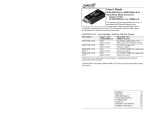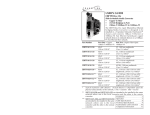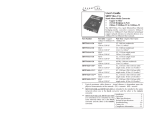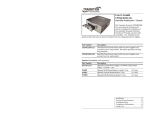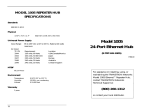Download Transition Networks CFETF1011-205 Network Card User Manual
Transcript
User’s Guide CFETF10xx-205 Slide-in-Module Media Converter • Fast Ethernet • Copper to Fiber • 100Base-TX to 100Base-FX Transition Networks CFETF10xx-205 series Fast Ethernet 100Base-TX to 100Base-FX media converters connect 100Base-TX twisted-pair copper cable to multimode or single mode 100Base-FX fiber-optic cable. The CFETF10xx-205 is also designed to be installed in a PointSystem™ chassis. Part Number CFETF1011-205 CFETF1013-205 CFETF1014-205 CFETF1015-205 CFETF1016-205 CFETF1017-205 CFETF1018-205 CFETF1019-205 CFETF1039-205 Port One - Copper 100Base-TX RJ-45 100 m (328 ft)* RJ-45 100 m (328 ft)* RJ-45 100 m (328 ft)* RJ-45 100 m (328 ft)* RJ-45 100 m (328 ft)* RJ-45 100 m (328 ft)* Port Two - Duplex Fiber-Optic 100Base-FX ST, 1300 nm multimode 2 km (1.2 miles)* SC, 1300 nm multimode 2 km (1.2 miles)* SC, 1310 nm single mode 20 km (12.4 miles)* SC, 1310 nm single mode 40 km (24.9 miles)* SC, 1310 nm single mode 60 km (32.3 miles)* SC, 1550 nm single mode 80 km (49.7 miles)* RJ-45 100 m (328 ft)* RJ-45 100 m (328 ft)* RJ-45 100 m (328 ft)* MT-RJ, 1300 nm multimode 2 km (1.2 miles)* LC, 1310 nm single mode 20 km (12.4 miles)* LC, 1300 nm multimode, 2 km (1.2 miles)* The CFETF1029-2xx model is the single mode, single fiber version of the media converter. For more information, see the CFETF1029-2xx user’s guide #33244 at: www.transition.com. Trademark Notice All trademarks and registered trademarks are the property of their respective owners. Copyright Restrictions © 2002 - 2005 Transition Networks. All rights reserved. No part of this work may be reproduced or used in any form or by any means - graphic, electronic, or mechanical - without written permission from Transition Networks. Printed in the U.S.A. 33234.J * Typical maximum cable distance. Actual distance is dependent upon the physical characteristics of the network installation. Installation . . . . . . . . . . . . . . . . . .3 Operation . . . . . . . . . . . . . . . . . . .6 Cable Specifications . . . . . . . . . .10 Technical Specifications . . . . . . .12 Troubleshooting . . . . . . . . . . . . .13 Contact Us . . . . . . . . . . . . . . . . .14 Compliance Information . . . . . . .15 CFETF10xx-205 Part Number CFETF1017-351 CFETF1017-353 CFETF1017-355 CFETF1017-357 * Port One - Copper 100Base-TX RJ-45 100 m (328 ft)* RJ-45 100 m (328 ft)* RJ-45 100 m (328 ft)* RJ-45 100 m (328 ft)* Port Two - Duplex Fiber-Optic 100Base-FX SC, 1510 nm single mode, CWDM 80km (49.7.miles)* SC, 1530 nm single mode, CWDM 80km (49.7.miles)* SC, 1550 nm single mode, CWDM 80km (49.7.miles)* SC, 1570 nm single mode, CWDM 80km (49.7.miles)* Typical maximum cable distance. Actual distance is dependent on the physical characteristics of the network. (TX) = transmit (RX) = receive Compliance Information CISPR22/EN55022 Class A & B + EN55024 CE Mark FCC Regulations This equipment has been tested and found to comply with the limits for a Class A & B digital device, pursuant to part 15 of the FCC rules. These limits are designed to provide reasonable protection against harmful interference when the equipment is operated in a commercial environment. This equipment generates, uses, and can radiate radio frequency energy and, if not installed and used in accordance with the instruction manual, may cause harmful interference to radio communications. Operation of this equipment in a residential area is likely to cause harmful interference, in which case the user will be required to correct the interference at the user's own expense. Canadian Regulations This digital apparatus does not exceed the Class A & B limits for radio noise for digital apparatus set out on the radio interference regulations of the Canadian Department of Communications. Le présent appareil numérique n'émet pas de bruits radioélectriques dépassant les limites applicables aux appareils numériques de la Class A & B prescrites dans le Règlement sur le brouillage radioélectrique édicté par le ministère des Communications du Canada. CAUTION: RJ connectors are NOT INTENDED FOR CONNECTION TO THE PUBLIC TELEPHONE NETWORK. Failure to observe this caution could result in damage to the public telephone network. Der Anschluss dieses Gerätes an ein öffentlickes Telekommunikationsnetz in den EGMitgliedstaaten verstösst gegen die jeweligen einzelstaatlichen Gesetze zur Anwendung der Richtlinie 91/263/EWG zur Angleichung der Rechtsvorschriften der Mitgliedstaaten über Telekommunikationsendeinrichtungen einschliesslich der gegenseitigen Anerkennung ihrer Konformität. In accordance with European Union Directive 2002/96/EC of the European Parliament and of the Council of 27 January 2003, Transition Networks will accept post usage returns of this product for proper disposal. The contact information for this activity can be found in the 'Contact Us' portion of this document. 2 24-hour Technical Support: 1-800-260-1312 International: 00-1-952-941-7600 [email protected] -- Click the “Transition Now” link for a live Web chat. 15 CFETF10xx-205 Contact Us Installation Technical Support Technical support is available 24 hours a day. US and Canada: 1-800-260-1312 International: 00-1-952-941-7600 CAUTION: Wear a grounding device and observe electrostatic discharge precautions when setting the 4-position switch and the jumpers. Failure to observe this caution could result in damage to, and subsequent failure of, the media converter. Transition Now Chat live via the Web with Transition Networks Technical Support. Log onto www.transition.com and click the Transition Now link. Set the 4-Position Switch Auto-Negotiation (up = enabled) Pause (up = enabled) Link Pass Through (up = enabled) • The 4-position switch is located on the circuit board. Web-Based Seminars Transition Networks provides seminars via live web-based training. Log onto www.transition.com and click the Learning Center link. • Use a small flat-blade screwdriver to set the recessed switches. E-Mail Ask a question anytime by sending an e-mail to our technical support staff. [email protected] 1. Auto-Negotiation up = Advertises 100 Mb/s Full-Duplex and Half-Duplex (only during Auto-Negotiation). Address Transition Networks 10900 Red Circle Drive Minnetonka, MN 55343, U.S.A. telephone: 952-941-7600 toll free: 800-526-9267 fax: 952-941-2322 Far End Fault (up = enabled) 1 2 3 4 down = Disables Auto-Negotiation. Operates at 100 Mb/s in the mode (either full- or half-duplex) of the attached device. 2. Pause (Applies ONLY if switch “1” is up AND the media converter is connected to auto negotiating device(s) capable of Pause Control Frame.) up = Allows negotiation of Pause Control Frame. down = Does not allow negotiation of Pause Control Frame. 3. down = Disables Link Pass-Through. Declaration of Conformity Name of Mfg: Transition Networks 10900 Red Circle Drive, Minnetonka MN 55343 U.S.A. Model: CFETF10xx-205 Series Media Converters Part Number(s): CFETF1011-205, CFETF1013-205, CFETF1014-205, CFETF1015-205, CFETF1016-205, CFETF1017-205, CFETF1018-205, CFETF1019-205, CFETF1039-205 Regulation: EMC Directive 89/336/EEC Purpose: To declare that the CFETF10xx-205 to which this declaration refers is in conformity with the following standards. CISPR 22: 1997+A1:2000; EN 55022:1998 A1:2000 Class A & B; EN 55024:1998; FCC Part 15 Subpart B; EN 61000-2-3:1995 A14:2000, EN 61000-3-3:1995; 21 CFR subpart J I, the undersigned, hereby declare that the equipment specified above conforms to the above Directive(s) and Standard(s). Link Pass-Through up = Enables Link Pass-Through. 4. Far-End Fault up = Enables Far-End Fault. down = Disables Far-End Fault. Set the hardware/software Jumper • The header for the jumper is located on the circuit board labeled “H” hardware mode and “S” software mode. • Use small needle-nose pliers to remove and position the jumper. Hardware May, 2008___ Stephen Anderson, Vice-President of Engineering Date Software 14 24-hour Technical Support: 1-800-260-1312 International: 00-1-952-941-7600 The four DIP switches control the function of the board in hardware mode. You can only view status via the Web or Focal Point interface. Software controls the function of the board. The DIP switches do not function in software mode. H S Hardware Mode H S Software Mode [email protected] -- Click the “Transition Now” link for a live Web chat. 3 CFETF10xx-205 Troubleshooting Installation -- Continued If the media converter fails, isolate and correct the failure by determining the answers to the following questions and then taking the indicated action: Set the AutoCross™ Jumper When the AutoCross feature is activated, it allows either straight-through or crossover cables to be used when connecting to 100Base-TX devices. AutoCross determines the characteristics of the connection and automatically configures the unit to link up, regardless of the cable configuration. • The jumper is located on the circuit board labeled “D” and “E”. • Use small needle-nose pliers to remove and position the jumper. Disable Enable Either straight-through or crossover twisted-pair copper cable must be installed, according to the site requirements. The media converter connects automatically to either straight-through or crossover twisted-pair copper cable. D Is the PWR LED on the media converter illuminated? NO • Is the media converter installed properly in the chassis? • Is the power cord properly installed in the chassis and at the external power source? • Does the external power source provide power? • Contact Technical Support: 1-800-260-1312 (Int’l: 00-1-952-7600). YES • Proceed to step 2. 2. Is the LKC LED on the media converter illuminated? NO • Check the twisted-pair cables for proper connection. • Contact Technical Support: 1-800-260-1312 (Int’l: 00-1-952-7600). YES • Proceed to step 3. 3. Is the LKF LED on the media converter illuminated? NO • Check the fiber cables for proper connection. • Verify that the TX and RX cables on the media converter are connected to the RX and TX ports, respectively, on the other device. • Contact Technical Support: 1-800-260-1312 (Int’l: 00-1-952-7600). YES • Proceed to step 4. 4. Is the RXC LED on the media converter flashing? NO • If there is no activity on the 100Base-TX port, proceed to step 5. • If there is activity on the 100Base-TX port, disconnect and reconnect the 100Base-TX cable to restart the initialization process. • Restart the workstation to restart the initialization process. • Contact Technical Support: 1-800-260-1312 (Int’l: 00-1-952-7600). YES • Proceed to step 5. 5. Is the RXF LED on the media converter flashing? NO • If there is activity on the 100Base-FX port, disconnect and reconnect the 100Base-FX cable to restart the initialization process. • Verify that the TX and RX cables on the media converter are connected to the RX and TX ports, respectively, on the other device. • Restart the workstation to restart the initialization process. • Contact Technical Support: 1-800-260-1312 (Int’l: 00-1-952-7600). YES • Contact Technical Support: 1-800-260-1312 (Int’l: 00-1-952-7600). E Disable AutoCross D 1. E Enable AutoCross NOTE: AutoCross is enabled by default.” Transition networks recommends leaving the jumper in the “enable” position. Install the media converter CAUTION: Wear a grounding device and observe electrostatic discharge precautions when installing the CFETF10xx-205 media converter. Failure to observe this caution could result in damage to or failure of, the media converter. 1. Carefully slide the media converter into the slot, aligning it with the slot guides. 2. Ensure that the converter is firmly seated into the slot. 3. Push in and rotate the attached panel fastener screw clockwise to secure the converter to the chassis. Point System Chassis Panel Fastener Slot Media Converter 4 24-hour Technical Support: 1-800-260-1312 International: 00-1-952-941-7600 [email protected] -- Click the “Transition Now” link for a live Web chat. 13 CFETF10xx-205 Installation -- Continued Technical Specifications For use with Transition Networks Model CFETF10xx-205 or equivalent. Standards IEEE 802.3™ Data Rate 100 Mb/s Dimensions 3.4" x 5.0" x 0.87" (86 x 185 x 22 mm) Weight 3 oz (91 g) (approximate) Power Consumption 3.5 watts, 200 mA @ 13.9 VDC MTBF 382,956 hours (MIL217F2 V5.0) (MIL-HDBK-217F) 1,456,260 hours (Bellcore7 V5.0) Environment Tmra*: Storage Temp: Humidity Altitude Warranty Lifetime Connect the Fiber Cable 1. Locate a 100Base-FX compliant fiber cable with male, two-stranded TX to RX connectors installed at both ends. 2. Connect the fiber cables to the CFETF10xx-205 media converter as described: • Connect the male TX cable connector to the female TX port. • Connect the male RX cable connector to the female RX port. 3. Connect the fiber cables to the other device (another media converter, hub, etc.) as described: • Connect the male TX cable connector to the female RX port. • Connect the male RX cable connector to the female TX port. 0 to 60°C (32 to 140°F ) -20 to 85°C (-4 to 185°F ) 5 to 95%, non condensing 0 to 10,000 feet Connect fiber cable to media converter as shown. *Manufacturer’s rated ambient temperature: Tmra range for the CFETF10xx-205 media converter depends on the physical characteristics and the installation configuration of the PointSystem™ chassis, in which the module will be installed. The information in this user’s guide is subject to change. For the most up-to-date information on the CFETF10xx-205 media converter, view the user’s guide online at: www.transition.com This product is certified by the manufacturer to comply with DHHS Rule 21/CFR, Subchapter J applicable at the date of manufacture. Connect fiber cable to other device (media converter, hub, etc.) as shown RX RX TX TX Connect the Twisted-Pair Copper Cable 1. CAUTION: Visible and invisible laser radiation when open. Do not stare into the beam or view directly with optical instruments. Locate or build 100Base-TX compliant cables, with male RJ-45 connectors installed at both ends. 2. CAUTION: Use of controls, adjustments or the performance of procedures other than those specified herein may result in hazardous radiation exposure. Connect the RJ-45 connector at one end of the cable to the RJ-45 port on the CFETF10xx-205 media converter. 3. Connect the RJ-45 connector at the other end of the cable to the RJ-45 port on the other device (switch, workstation, etc.). Point System Chassis RJ-45 Port Media Converter 12 24-hour Technical Support: 1-800-260-1312 International: 00-1-952-941-7600 RJ-45 Port On other device (workstation, switch, etc.) [email protected] -- Click the “Transition Now” link for a live Web chat. 5 CFETF10xx-205 Cable Specifications Operation CFETF1029-2xx Status LEDs The CFETF10xx-205 media converter is designed to operate without user intervention. Use the status LEDs to monitor the media converter operation in the network. PWR On Connection to external power. LKF On The fiber link has been established. LKC On The copper link has been established. RXF Flashing The fiber link is receiving data. RXC Flashing The copper link is receiving data. PWR RFX LKF RXC LKC TX Fiber Optic Transmitter Power: Fiber Optic Receiver Sensitivity: Link Budget: CFETF1017-351 Fiber Optic Transmitter Power: Fiber Optic Receiver Sensitivity: Link Budget: CFETF1017-353 Fiber Optic Transmitter Power: Fiber Optic Receiver Sensitivity: Link Budget: RX CFETF1017-355 Fiber Optic Transmitter Power: Fiber Optic Receiver Sensitivity: Link Budget: Product Features CFETF205 Auto-Negotiation The Auto-Negotiation feature allows the CFETF10xx-205 media converter to automatically configure itself to achieve the best possible mode of operation over a link. The media converter broadcasts its speed (100 Mb/s) and duplex capabilities (full or half) to the other devices and negotiates the best mode of operation. Auto-Negotiation allows quick and easy installation because the optimal link is established automatically. No user intervention is required. CFETF1017-357 Fiber Optic Transmitter Power: Fiber Optic Receiver Sensitivity: Link Budget: -- Continued 1300 nm multimode min: -19.0 dBm max: -14.0 dBm min: -30.0 dBm max: -14.0 dBm 11 dB 1510 nm multimode min: -5.0 dBm max: 0.0 dBm min: -34.0 dBm max: -3.0 dBm 29 dB 1530 nm multimode min: -5.0 dBm max: 0.0 dBm min: -34.0 dBm max: -3.0 dBm 29 dB 1550 nm multimode min: -5.0 dBm max: 0.0 dBm min: -34.0 dBm max: -3.0 dBm 29 dB 1570 nm multimode min: -5.0 dBm max: 0.0 dBm min: -34.0 dBm max: -3.0 dBm 29 dB The fiber optic transmitters on this device meet Class I Laser safety requirements per IEC-825/CDRH standards and comply with 21 CFR1040.10 and 21CFR1040.11. A scenario where the media converter is linked to a non-negotiating device, disable Auto-Negotiation. In this instance, the mode of operation will drop to the least common denominator between the two devices (e.g., 100 Mb/s, half-duplex). Disabling this feature enables forcing the connection to the best mode of operation. Half-Duplex Network (512-Bit Rule) In a half-duplex network, the maximum cable lengths are determined by the round trip delay limitations of each Fast Ethernet collision domain. (A collision domain is the longest path between any two terminal devices, e.g., a terminal, switch, or router.) The 512-Bit Rule determines the maximum length of cable permitted by calculating the round-trip delay in bit-times (BTU) of a particular collision domain. If the result is less than or equal to 512 BTU, the path is good. For more information on the 512-Bit Rule, see the white paper titled “Collision Domains” on the Transition Networks website at: www.transition.com 6 24-hour Technical Support: 1-800-260-1312 International: 00-1-952-941-7600 [email protected] -- Click the “Transition Now” link for a live Web chat. 11 CFETF10xx-205 Operation -- Continued Cable Specifications The physical characteristics must meet or exceed IEEE 802.3™ specifications. Fiber Cable Bit Error Rate: Single mode fiber (recommended): Multimode fiber (recommended): Multimode fiber (optional): <10-9 9 µm 62.5/125 µm 100/140, 85/140, 50/125 µm CFETF1011-205 Fiber Optic Transmitter Power: Fiber Optic Receiver Sensitivity: Link Budget: 1300 nm multimode min: -19.0 dBm max: -14.0 dBm min: -30.0 dBm max: -14.0 dBm 11.0 dB CFETF1013-205 Fiber Optic Transmitter Power: Fiber Optic Receiver Sensitivity: Link Budget: 1300 nm multimode min: -19.0 dBm max: -14.0 dBm min: -30.0 dBm max: -14.0 dBm 11.0 dB CFETF1014-205 Fiber-optic Transmitter Power: Fiber-optic Receiver Sensitivity: Link Budget: 1310 nm single mode min: -15.0 dBm max: -8.0 dBm min: -31.0 dBm max: -8.0 dBm 16.0 dB CFETF1015-205 Fiber-optic Transmitter Power: Fiber-optic Receiver Sensitivity: Link Budget: 1310 nm single mode min: -8.0 dBm max: -2.0 dBm min: -34.0 dBm max: -7.0 dBm 26.0 dB CFETF1016-205 Fiber-optic Transmitter Power: Fiber-optic Receiver Sensitivity: Link Budget: 1310 nm single mode min: -5.0 dBm max: 0.0 dBm min: -34.0 dBm max: -7.0 dBm 29.0 dB CFETF1017-205 Fiber-optic Transmitter Power: Fiber-optic Receiver Sensitivity: Link Budget: 1550 nm single mode min: -5.0 dBm max: 0.0 dBm min: -34.0 dBm max: -7.0 dBm 29.0 dB CFETF1018-205 Fiber Optic Transmitter Power: Fiber Optic Receiver Sensitivity: Link Budget: 1300 nm multimode min: -19.0 dBm max: -14.0 dBm min: -33.5 dBm max: -14.0 dBm 14.5 dB CFETF1019-205 Fiber-optic Transmitter Power: Fiber-optic Receiver Sensitivity: Link Budget: 1310 nm single mode min: -15.2 dBm max: -8.0 dBm min: -32.5 dBm max: -3.0 dBm 17.3 dB Full-Duplex Network In a full-duplex network, maximum cable lengths are determined by the type of cables used. See page 1 (front cover) for available CFETF10xx-205 models. The 512-Bit Rule does not apply in a full-duplex network. Pause Control Frame The pause control feature can improve network performance by allowing one end of the link to signal the other to discontinue frame transmission for a set period of time to relieve buffer congestion. NOTE: If the pause control feature is present on ALL network devices attached to the media converter(s), enable the pause control feature on the media converter(s). Otherwise, disable this feature. Link Pass-Through When the Link Pass-Through feature is activated, it allows the media converter to monitor both the fiber and copper RX (receive) ports for loss of signal. In the event of a loss of an RX signal (1), the media converter will automatically disable the TX (transmit) signal (2), thus, “passing through” the link loss (3). The far-end device is notified automatically of the link loss (4), which prevents the loss of valuable data transmitted unknowingly over an invalid. media converter A disables the fiber TX link Near-End Device Media Converter A 1 3 Media Converter B Far-End Device 4 media converter B disables the copper link Far-End Fault When a fault occurs on an incoming fiber link (1), the media converter transmits a Far-End Fault signal on the outgoing fiber link (2). In addition, the Far-End Fault signal also activates the Link Pass-Through, which in turn disables the link on the copper portion of the network (3) and (4). original fault on the fiber link 4 Media Converter A media converter A disables the copper link 24-hour Technical Support: 1-800-260-1312 International: 00-1-952-941-7600 2 original fault on the copper link Near-End Device 10 media converter B loses the fiber RX link 1 2 Far-End Fault signal is sent Media Converter B 3 Far-End Device media converter B disables the copper link [email protected] -- Click the “Transition Now” link for a live Web chat. 7 CFETF10xx-205 Operation -- Continued Copper Cable SUMP See the on-line documentation that comes with Transition Networks FocalPoint™ software for applicable commands and usage. Use SUMP at an attached terminal or at a remote location to monitor the following media converter activities: • Media-converter power • Copper link and fiber link status • Twisted-pair cable length • Hardware switch settings • Fault condition Also, use SUMP to enter network commands that: • Enable/disable full-/half-duplex • Enable/disable Link Pass-Through (LPT) • Enable/disable Far-End Fault (FEF) • Enable/disable Pause • Enable/disable AutoCross • Power down the media converter 8 Cable Specifications 24-hour Technical Support: 1-800-260-1312 International: 00-1-952-941-7600 Category 5: (minimum requirement) Gauge 24 to 22 AWG Attenuation 22.0 dB /100m @ 100 MHz Maximum Cable Distance 100 meters • Straight-through or crossover twisted-pair cable may be used. • Shielded twisted-pair or unshielded twisted-pair may be used. • Pins 1&2 and 3&6 are the two active pairs in an Ethernet network . • Use only dedicated wire pairs for the active pins: (e.g., blue/white & white/blue, orange/white & white/orange, etc.) • Do not use flat or silver satin wire. Straight-Through Cable Crossover Cable Twisted Pair #1 Twisted Pair #1 Twisted Pair #2 Twisted Pair #2 [email protected] -- Click the “Transition Now” link for a live Web chat. 9











